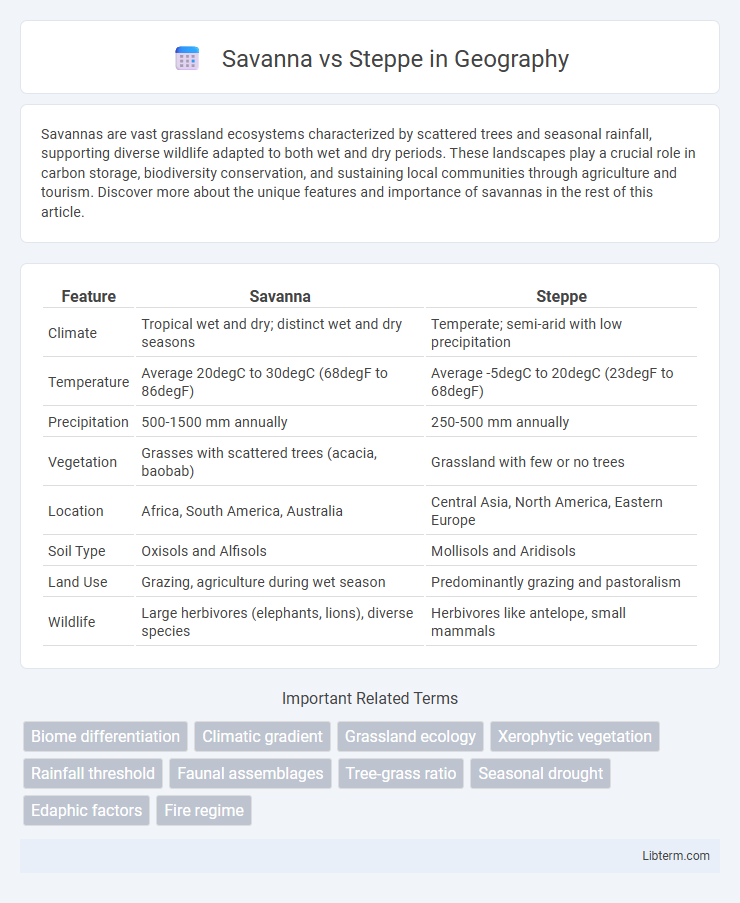Savannas are vast grassland ecosystems characterized by scattered trees and seasonal rainfall, supporting diverse wildlife adapted to both wet and dry periods. These landscapes play a crucial role in carbon storage, biodiversity conservation, and sustaining local communities through agriculture and tourism. Discover more about the unique features and importance of savannas in the rest of this article.
Table of Comparison
| Feature | Savanna | Steppe |
|---|---|---|
| Climate | Tropical wet and dry; distinct wet and dry seasons | Temperate; semi-arid with low precipitation |
| Temperature | Average 20degC to 30degC (68degF to 86degF) | Average -5degC to 20degC (23degF to 68degF) |
| Precipitation | 500-1500 mm annually | 250-500 mm annually |
| Vegetation | Grasses with scattered trees (acacia, baobab) | Grassland with few or no trees |
| Location | Africa, South America, Australia | Central Asia, North America, Eastern Europe |
| Soil Type | Oxisols and Alfisols | Mollisols and Aridisols |
| Land Use | Grazing, agriculture during wet season | Predominantly grazing and pastoralism |
| Wildlife | Large herbivores (elephants, lions), diverse species | Herbivores like antelope, small mammals |
Introduction to Savanna and Steppe Ecosystems
Savanna ecosystems are characterized by a mix of grasslands and scattered trees, thriving in regions with seasonal rainfall and supporting diverse wildlife such as elephants and lions. Steppe ecosystems consist predominantly of treeless grasslands found in semi-arid climates, home to species like antelopes and ground squirrels. Both ecosystems play crucial roles in biodiversity maintenance, carbon storage, and support unique flora adapted to variable precipitation patterns.
Geographic Distribution and Climate Differences
Savannas primarily span tropical regions in Africa, South America, and Australia, characterized by a warm climate with distinct wet and dry seasons supporting scattered trees and grasses. Steppes are found mainly in temperate zones such as Central Asia, Eastern Europe, and parts of North America, with semi-arid climates featuring cold winters and hot summers that sustain extensive grasslands with sparse tree cover. The key geographic distinction lies in savannas' tropical placement with seasonal rainfall patterns, contrasting with steppes' temperate latitudes and more variable precipitation.
Soil Characteristics in Savannas and Steppes
Savanna soils are typically acidic and nutrient-poor, often classified as Ferralsols or Acrisols, with a sandy texture that supports grasses and scattered trees. Steppe soils, predominantly Chernozems, are rich in organic matter and nutrients, featuring a dark, fertile topsoil ideal for grassland vegetation. The contrasting soil fertility and composition significantly influence the vegetation types and ecosystem productivity in savannas and steppes.
Dominant Vegetation Types
Savannas are characterized by a mixture of tall grasses and scattered trees, primarily drought-resistant species like acacias and baobabs, adapted to seasonal rainfall patterns. Steppes feature predominantly short grasses and shrubs, such as feather grass and sagebrush, thriving in semi-arid climates with less tree cover. The distinct vegetation types reflect adaptations to their unique climate conditions, influencing biodiversity and ecosystem functions in these biomes.
Adaptations of Flora and Fauna
Savannas feature drought-resistant grasses and widely spaced trees like acacias, adapted to withstand seasonal fires and prolonged dry periods, while their fauna includes large herbivores such as elephants and giraffes, which have evolved to browse selectively and migrate for water. Steppes support hardy grasses and shrubs adapted to cold winters and limited rainfall, with fauna including grazing animals like saiga antelopes and burrowing small mammals that survive harsh temperature extremes and scarce water. Both ecosystems demonstrate specialized adaptations that enable plants and animals to thrive under differing climatic stresses and resource availability.
Seasonal Variations and Weather Patterns
Savannas experience distinct wet and dry seasons, with rainfall concentrated during the wet season, supporting grasses and scattered trees adapted to periodic droughts. Steppes have more uniform precipitation throughout the year, typically receiving less rainfall than savannas, resulting in predominantly grassy plains with fewer trees. Temperature fluctuations in steppes are more extreme, with cold winters and hot summers, while savannas maintain warmer and more stable temperatures year-round.
Human Impact and Land Use Practices
Savanna regions experience extensive human impact due to agriculture, grazing, and urban expansion, leading to habitat fragmentation and biodiversity loss. Steppes are primarily used for dryland farming and livestock grazing, with overgrazing often resulting in soil erosion and desertification. Both ecosystems face challenges from unsustainable land use practices that threaten ecological balance and long-term productivity.
Biodiversity Comparison: Species Richness
Savannas exhibit higher species richness than steppes due to greater structural complexity, hosting diverse trees, grasses, and numerous animal species such as elephants, lions, and various bird species. Steppes have fewer plant layers, primarily dominated by grasses and herbaceous plants, supporting species adapted to open, dry environments like rodents, raptors, and drought-resistant insects. The biodiversity in savannas benefits from seasonal rainfall patterns that promote a wider variety of flora and fauna, contrasting with the more uniform and arid conditions of steppes.
Ecological Importance and Environmental Roles
Savannas, characterized by scattered trees and grasslands, support high biodiversity by providing habitats for large herbivores and predators, playing a crucial role in nutrient cycling and carbon storage. Steppes, dominated by grasses and few trees, contribute significantly to soil erosion control and serve as important carbon sinks due to extensive root systems. Both ecosystems regulate local climates and water cycles, maintaining ecological balance and supporting agricultural productivity.
Conservation Challenges and Future Outlook
Savannas face conservation challenges such as habitat fragmentation and invasive species that threaten biodiversity, while steppes are primarily impacted by agricultural expansion and desertification. Both ecosystems require sustainable land management practices and restoration efforts to maintain soil health and native flora. Future outlook depends on integrating climate resilience strategies with conservation policies to prevent further degradation and support ecosystem services.
Savanna Infographic

 libterm.com
libterm.com